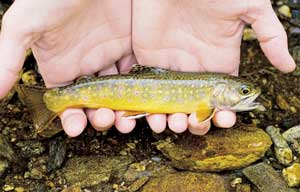
The brook trout is one of the most beloved fish for American anglers.
The “brookie” is beautifully colored, resides in only the most scenic places, and is considered to be somewhat naïve — the last reason is probably why it’s a favorite of fly fishermen in particular.
In South Carolina, brook trout are confined to a precious few remote streams in the mountainous part of the state. Brook trout require clean, cold, oxygenated water — a rarity in any southern state. Brook trout cannot survive in sustained water temperatures of 77 degrees or higher and prefer water temperatures below 68 degrees.
The brook trout, not actually a trout but a char, was originally an artic, coldwater fish that migrated southward during the last ice age 10,000 years ago. When the Earth began to warm and the glaciers receded, the brook trout population followed. But a small percentage remained, seeking a thermal refuge in the cold mountain streams along the spine of the Appalachian Mountain range.
For centuries, brook trout flourished in eastern streams where water temperatures and conditions were optimal. Industrialization, heavy logging, and the introduction of non-native brown and rainbow trout late in the 19th century eventually pushed the brookies into high-elevation streams where they cling tenuously to existence today.
Brook trout do not compete well with more aggressive rainbows and browns. Rainbow trout, in particular, are highly adaptable to most stream conditions and will out-compete brookies for the available food sources. As a result, successful brook trout habitat must not only meet the narrow requirements of a pristine, cold-water environment, but it must also have a natural barrier such as an impassable waterfall to keep rainbow and brown trout from invading its territory.
In 2005, to help brook trout gain a stronger foothold in suitable South Carolina streams, the S.C. Department of Natural Resources (SCDNR) began a Southern Appalachian brook trout reintroduction program. With help from Trout Unlimited, the U.S. Forest Service, the National Park Service, Clemson University, and the South Carolina Wildlife Federation, the SCDNR reclaimed King Creek, a small headwater stream and tributary of the Chattooga River, and stocked it with Southern Appalachian strain brook trout.
The restoration process included killing off the existing resident brown and rainbow trout in King Creek. Although controversial, it was a necessary step in the restoration program.
Steve Moore, the head fisheries biologist for the Great Smoky Mountains National Park, was enlisted to bring his knowledge and experience in using Antimycin to eliminate the browns and rainbows.
A 70-foot waterfall, King Creek Falls, is the natural barrier that forms the downstream border of the new habitat and prevents rainbow and brown trout from repopulating the area. At that point, potassium permanganate was added into the water as a neutralizing agent to offset the Antimycin downstream of the targeted area.
The SCDNR restocked the reclaimed area of the stream with the Southern Appalachian strain of brook trout. Since the stocking occurred, successful spawning has taken place, and young-of-the-year were detected in 2006. This success has led the SCDNR to target several other small streams considered suitable habitat for brook trout.
In 2006, Trout Unlimited gave the Chattooga River chapter an Embrace-A-Stream grant for the restoration of brook trout in South Carolina. This will give local Trout Unlimited volunteers and the SCDNR more resources to restore more brook trout habitat in the future.
Most brook trout do not live past four years of age. This fact, combined with the relatively-sterile water conditions, keeps the average size brookie very small. So why replace bigger, stronger rainbows and browns with smaller, more fragile brookies?
As a life-long angler, my fishing philosophy has always been “Big fish are better than small fish.”
But catching a diminutive wild brook trout is about much more than inches or pounds. Holding one of these brilliant, cold, gems in your hand is like reaching over thousands of years to Earth’s Pleistocene era.



Be the first to comment